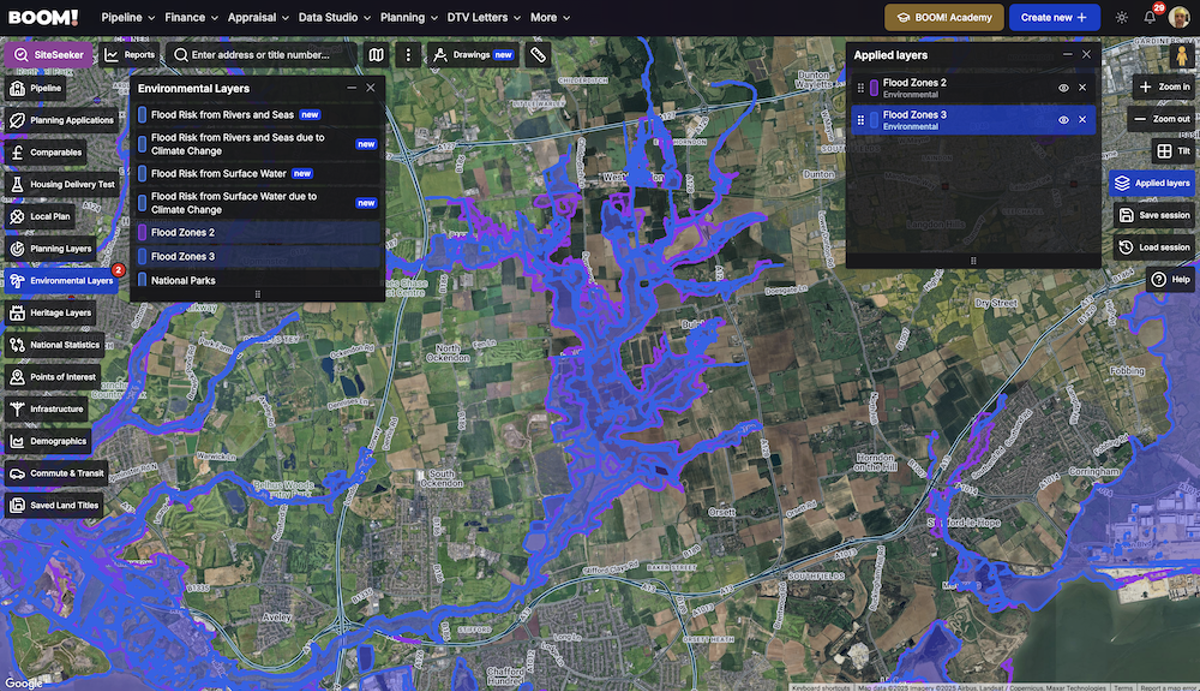How to Navigate Flood Zones 2 & 3 and Find Profitable Sites (Without Getting Swamped)







Picture this: You spot a bargain plot of land in a nice area. The price seems too good to be true – and it might be. Two small words on the survey could be the culprit: “Flood Zone.” In the UK, that label can make or break a development deal. Many newcomers overlook flood zones when sourcing land, only to have a heavy rain turn their site into a swimming pool. It’s not rare bad luck – some 6.3 million properties in England lie in areas at risk of flooding. Ignoring this risk can literally sink your project.
What Are Flood Zones 2 and 3?
In simple terms, flood zones are how the UK categorises flood risk on land. Flood Zone 1 is low risk (least likely to flood). Flood Zone 2 means medium probability – roughly a 0.1% to 1% chance of flooding each year (between a 1 in 1000 and 1 in 100 chance). Flood Zone 3 is high risk – over a 1% yearly chance of floods (i.e. 1 in 100 or more frequent). Local planners even subdivide Zone 3 into 3a and 3b: 3b is the functional floodplain – land that will flood in severe conditions (around a 1 in 20 chance every year) and is generally left undeveloped. In short, Zone 3 is the red alert zone, and Zone 2 is orange alert.
Why do these zones matter? Because they trigger legal and financial hurdles. If your site falls in Zone 2 or 3, you must submit a formal Flood Risk Assessment with your planning application – no ifs or buts. Fail to do so properly, and the council can refuse your permission outright. Planners will also ask: “Could you build this on safer ground instead?” This is the sequential test, a rule that steers development to lower-risk areas first. If a safer site is available, your high-risk plot might get rejected on that basis alone. In the UK’s planning system, flood zones 2 and 3 are huge red flags – and for good reason.
Here’s the catch: Flood zone maps mainly consider rivers and sea flooding. They don’t include every tiny stream, clogged drain or future climate change impact. So even land in Zone 1 (deemed “safe”) can flood under the right conditions. A sudden torrential downpour can overwhelm any urban drainage – and surface water flooding can strike even on a hilltop. In fact, in many recent floods, areas outside known floodplains still got inundated by flash floods. This means no site is 100% flood-proof, and as a developer you need to assess all flood risks, not just what the basic zone map shows.
How Flood Zones 2 & 3 Can Impact Your Development
Choosing a site in Flood Zone 2 or 3 isn’t an automatic “no-go,” but it does mean steeper challenges. Here’s how these high-risk zones can affect your project:
Planning Delays & Costs: Regulators will put your application under a microscope. Expect to hire specialists to produce a detailed Flood Risk Assessment and possibly redesign your project to satisfy safety tests. Councils often demand evidence that your project won’t raise flood danger elsewhere. All this adds months of paperwork and thousands in fees to your timeline. And there’s still a risk they say “no” if the site is simply too risky without costly mitigations.
Construction Headaches: Building on a flood-prone plot means additional engineering. You might need to raise foundations, install heavier drainage systems, or use materials that withstand flood water. For example, critical living areas may have to be set on upper floors, with only garages or storage at ground level. These “flood-proof” design tweaks cost money and can reduce the usable land area (no basements, perhaps elevated access, etc.). Every extra pound spent on flood mitigation is a pound off your profit margin.
Insurance and Finance Woes: High flood risk doesn’t just scare planners – it spooks insurers and lenders. Insuring a building in Flood Zone 3 can be extremely expensive (if insurance is available at all). Without insurance, many banks won’t offer a mortgage on a property. In fact, Britain’s largest building society, Nationwide, now refuses to lend on some high-risk homes entirely. Other major lenders have signaled they may follow suit if a site can’t get affordable coverage. This means even if you build it, your buyers might struggle to finance it – a potential kiss of death for selling the units. No buyer wants a home they can’t insure or mortgage easily.
Marketability & Reputation: Think about the long term. Homes that regularly flood will earn you a terrible reputation as a developer. You don’t want to be the person who sold clients a house that becomes a waterlogged disaster. Homebuyers are becoming savvy – half of new-build owners worry climate change will impact their property. Nearly 1 in 5 owners of recently-built homes feel their home is in the wrong place due to flood risk. That’s a lot of regret. If you build in a flood zone without robust protections, you’re inviting buyer remorse and possible legal issues down the line. Protect your future business by avoiding obvious flood traps or handling them with absolute care.
Outsmarting the Flood Zones: Your Competitive Edge
Here’s the empowering part: knowing about Flood Zones 2 and 3 gives you an edge. Most beginners shy away from doing this homework – or blunder into deals obliviously. Don’t be that person. By checking flood risk early, you can save yourself from costly mistakes and even spot hidden opportunities (like a site everyone ignored that you can make viable with the right plan).
Act now, not later. Flood risk isn’t static – it’s increasing. With climate change, up to 1 in 4 UK properties could be at flood risk by 2050. Every year, insurance gets pricier and regulations tighter. The sooner you build flood checks into your routine, the better. It’s far cheaper to walk away from a high-risk plot before you buy, than to retrofix a flooded development or, worst-case, watch your project literally wash away. Delay is costly – financially and emotionally.

Leverage PropTech to stay ahead. The good news is you don’t need to wade through dusty files or become a hydrologist to assess flood zones. Property technology platforms (like BOOM!) put comprehensive flood data at your fingertips. These tools pull together Environment Agency flood maps, surface water risk layers, and more in one interactive map. With a few clicks, you can see if a parcel is in Zone 2 or 3, whether it’s near a river, and even if it benefits from any flood defences. A quick search can reveal if a plot is high-risk or clear – no guesswork, no nasty surprises. By screening sites in seconds, you filter out the obvious flood nightmares and focus on safer, profitable opportunities. Meanwhile, less-informed competitors might waste months on a doomed site. Knowledge is power – and you’ll have it instantly.
Don’t let flood zones scare you off completely. If a site is perfect in all other ways, being in Zone 2 (medium risk) might be manageable with the right design and approvals. Some developers even turn it to their advantage – for instance, negotiating a lower land price due to the stigma, then investing in flood resilience measures to make the project viable. That said, go in with eyes open and calculators ready. Factor in the cost of elevating structures, waterproofing, sustainable drainage, insurance, and extended approval times. Consult a flood risk engineer if needed. Sometimes, a site in Zone 2 can be made nearly as safe as Zone 1 with modern engineering. But Zone 3, especially functional floodplain (3b), is often best left to the experts or avoided for residential projects. As a newcomer, you don’t need unnecessary hurdles. There are plenty of fish in the sea – no need to catch the one that’s underwater.
Bottom line: Flood zones 2 and 3 are a crucial piece of the due diligence puzzle for any UK property developer. By respecting these risk zones, you protect your investment, your future buyers, and your own reputation. Incorporate flood risk checks into your site sourcing process from day one. Use the latest data – whether via the Environment Agency’s online flood map or a more advanced all-in-one platform like BOOM! – to know exactly what you’re buying into. This is how you turn a potential threat into a competitive advantage. While others roll the dice and hope for dry weather, you’ll be the savvy developer who only builds on solid (and dry) ground.
Empower yourself with information and tools, and you won’t get swamped. Every flood-free project you complete will boost your confidence and credibility. So go out there and find those profitable sites – just be sure to check for any blue patches on the map first! With preparation and the right tech in your toolkit, you can achieve great results without getting in over your head (or underwater). Stay safe, stay sharp, and happy developing!
To better understand how you can leverage Flood Zones sign up for a 7 day FREE trial or book a call with us and let us show you. We also offer free tools which help you understand whether a postcode is at risk of Flood Zone 2 or Flood Zone 3.